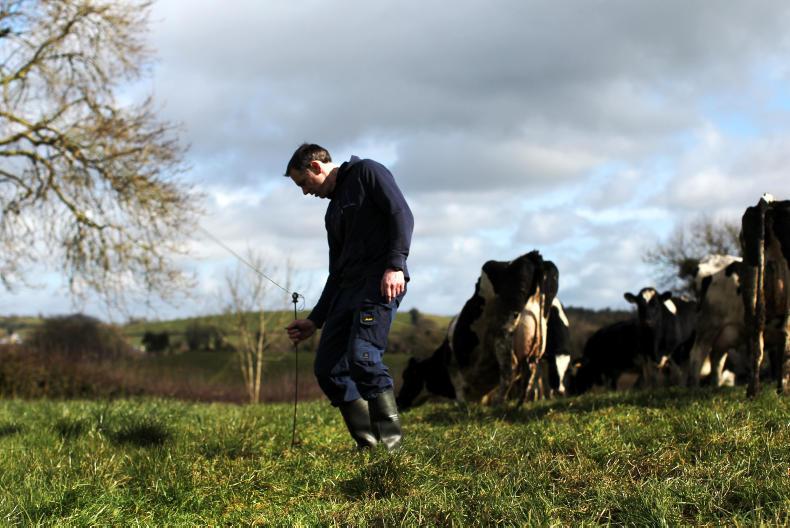Charles is milking 115 cows on the farm with a grazing block of 32ha. The farm has moved from a split 70/30 spring/autumn-calving herd four years ago to a 100% spring-calving herd. Calving started this year on 5 February with all cows and heifers calved in 13 weeks on the farm. Managing the spring workload and labour availability with minimal investment are two of the key drivers for Charles. Low-maintenance cows, compact calving and good fertility performance are all key aspects for any production system, and particularly so for Charles who is developing a fertile herd to capitalise on the good grazing block on the farm.
Milk sales for 2017 are up on the same period last year, with milk volume up 70,000 litres in the first six months of 2017. Total solids for the same period are up 20% on 2016 coming from the increased volume and higher milk protein, which is up 0.2% on the 2016 figure for the first six months. The plan for the herd is to continue focusing on improving milk solids and fertility, with better breeding and sire selection.

The cow type on the farm is moving towards a Jersey crossbred-type cow from the existing black and white Friesian cow on the farm. It’s early days – by 2018 the herd will only be 25% jersey cross. The rationale for this approach is to increase milk solids relatively fast with hybrid vigour from cross breeding. Also Charles is a one-man operation, with additional help hired in only for peak periods. He needs a low-maintenance and easily managed cow for the system. The Jersey cross cow will bring more milk solids per hectare, is lighter and easier to manage at the shoulders of the grazing season when ground conditions are wet and difficult to manage on this farm.
Based on projected milk solids, this will take total solids per ha to 1,452kg/ha for the farm
.
Stocking rate on the platform has increased from 3.35 cows/ha last year to 3.59 cows/ha. Based on projected milk solids, this will take total solids per ha to 1,452kg/ha for the farm. Higher protein this year is also feeding in to this calculation, with the herd currently producing 1.85kg solids/cow/day. So a combination of higher protein coupled with the higher stocking rate on the platform is projected to deliver 240kg/ha more solids for 2017, potentially an additional €30,000 in milk sales.
Last year, this platform had an average growth of 13.2t DM/ha.
Maximising growth on this farm is key. Yes, weather conditions play a major role in grass growth but soil fertility must be correct, or at least attempting to correct it in order to capitalise on the grass growth. Soil analysis for the farm revealed significant shortfalls for key nutrients on the farm back in 2015, with only 14% of the grazing block optimal for grass growth based on soil pH, phosphorus, and potash. Based on 2017 soil analysis, soil fertility has improved with 70% of the grazing block now optimal for grass growth with this filtering through to increase average grass growth on the farm. Last year, this platform had an average growth of 13.2t DM/ha.
Charles Clarke Bailieborough, Co Cavan
We started breeding on 4 May this year, with the heifers starting two days later on 6 May. We submitted the 110 cows in the first six weeks of breeding and five were not served and will be culled. About 30 milking cows have been seen in heat since, so this gives us a non-return rate of about 73%.
In total, 42 heifers have gone for AI service and I am using a teaser bull with paint ball to help with heat detection along with tail patches. A jersey AI sire OKT was used on Friesian heifers, and SEW has been used on crossbred heifers.
The 45 heifers are more than I need for next year as replacements. However, with the genetic gain in terms of milk solids and fertility I plan to bring them all in to the herd. Stocking rate can’t increase much more on the farm, so I will have to sell cows and I will base this on lower genetics in relation to solids and fertility. Currently, my herd EBI is €59, which is below national average and way too low for where I want it.
Sires used this year include PSQ, FR2079, FR2385, FR4206, Fr2339, FR4018 on the milking herd. Based on the fertility performance so far calving will be over in 10 weeks in 2018. This will place additional pressure on calving and calf-rearing facilities. The plan is to hire additional labour over this busy period next year.
Farm output is up with a good start to the grazing season helping this year. Ideal weather conditions on this farm in April and May have helped. I held cows on 3kg of concentrate all through breeding, and grass quality has been good all through.
At this stage, there has been no change in farm spending with costs remaining similar to 2016. A small amount of land improvement work was completed early this year and I plan to purchase a quad. Other than this, costs should remain unchanged from 2016, providing me with a chance to build a cash reserve for future developments.
Monday Management: Improving milk protein percent
Dairy markets: milk powder market softens ahead of this week’s GDT
